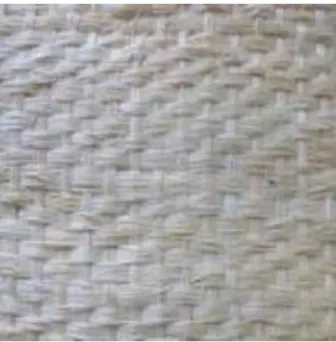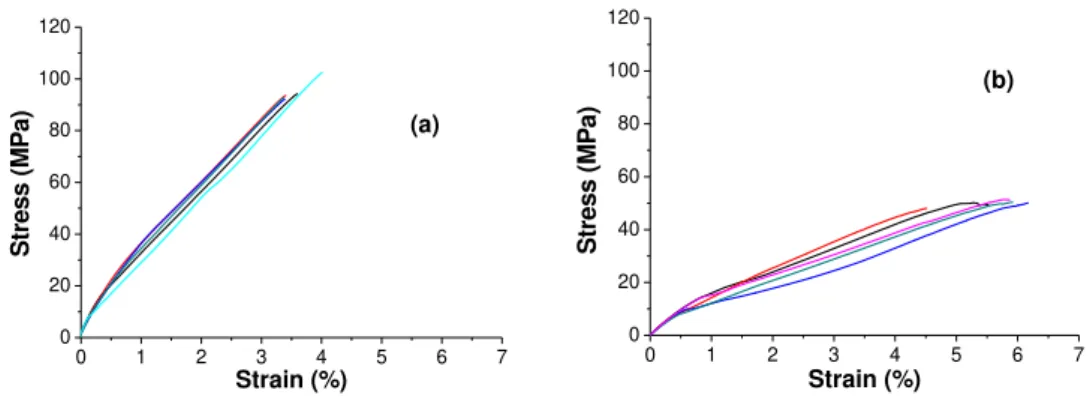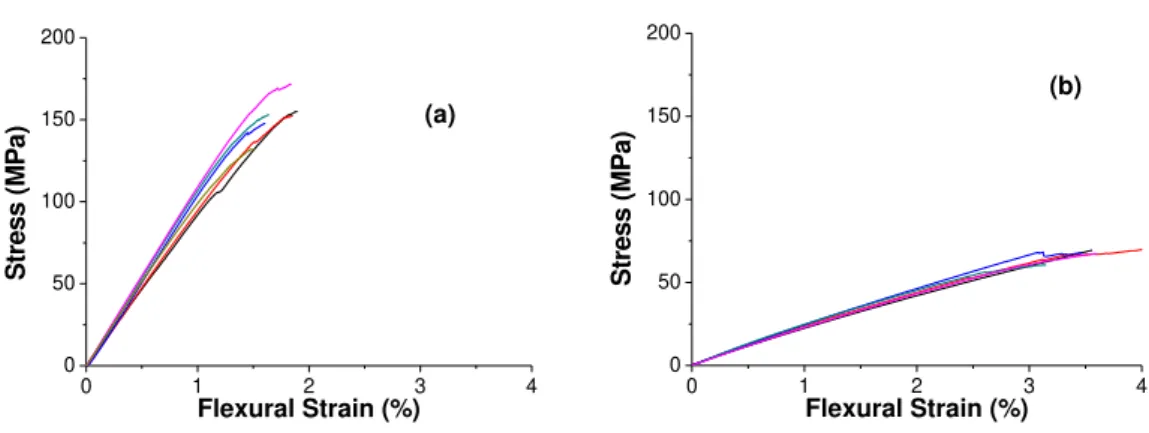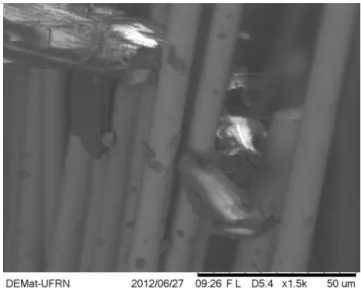ISSN 1517-7076 artigo e-12246, 2018
Autor Responsável: Elmo Thiago Lins Cöuras Ford Data de envio: 05/07/2017 Data de aceite: 19/09/2017
10.1590/S1517-707620180004.0580
Mechanical behavior and water absorption
in sisal/glass hybrid composites
Camila Cruz da Silva 2,Raimundo Carlos Silverio Freire Júnior 1, Elmo Thiago Lins Cöuras Ford 1, Camilla Medeiros Dantas 2, Jayna Kátia Dionisio dos Santos 3, Eve Maria Freire de Aquino1
1 Federal University of Rio Grande do Norte - UFRN– PPGEM, Av. Lagoa Nova, S/N, Natal, Rio Grande do Norte, Bra-zil.
2 Federal Institute of Science and Technology of Bahia, Vitória da Conquista, Bahia, Brazil.
3 Federal Institute of Science Education and Technology of Ceara, Jaguaribe, Ceará, Brazil.
e-mail: elmocouras@hotmail.com
ABSTRACT
This study aimed to assess the effect of hybridization on thermomechanical properties and water absorption of composite materials, by introducing sisal fiber tissue into the material. To that end, two composite material plates were manufactured, the first with five layers of E-glass reinforcement mat and the second with three layers of E-glass fiber interspersed with two layers of sisal fibers, both used as an orthophthalic polyester resin matrix. The material was then submitted to tensile, three-point bending and water absorption tests. It was observed that hybridization causes a change in both the final strength and stiffness of the material. Keywords: Composite material, water absorption, mechanical properties, natural fibers.
1. INTRODUÇÃO
Due to the search for new technologies and materials, studies on polymer composites have been gaining ground in a number of industrial sectors, with the aim of reducing costs and the damage caused to the envi-ronment. In this context, several researchers [1-7], have applied natural fibers with reinforcement in compo-sites, in order to decrease the industrial use of synthetic fibers. Unfortunately, the development of composites made solely with natural fibers significantly reduces their mechanical properties compared to those made with synthetic fibers. Thus, hybridization could be an alternative to using natural fibers without a significant loss of strength and stiffness [8-11].
Another characteristic of natural fibers is their ability to absorb water (hydrophilic) [12-15]. Thus, it is always important to assess the effects of this phenomenon on the final mechanical performance of the materi-al.
Among the natural fibers reported in the literature, such as pineapple, jute, coconut, curauá, sisal, rami [16-21], it was decided to assess the use of sisal fiber due to its extensive production in Brazil (254,427 t/year (IBGE) (Brazilian Institute of Geography and Statistics), biodegradability, recyclability, low density, non-abrasiveness, low energy consumption, low cost and ready availability in the market. There are several litera-ture references [22-25], showing that sisal fiber can be used as reinforcement with both thermoplastic (Poly-ethylene, PVC, Polypropylene) and thermoset matrices (Polyester and Epoxy). The orthophthalic Polyester Resin (UPR) was used as a matrix because of its low cost and ease of lamination.
2. MATERIALS AND METHODS
2.1 Manufacturins Process
Unsaturated orthophthalic polyester resin, pre-accelerated and catalyzed with 1 % by weight of ethyl methyl ketone (MEK-P), was used to manufacture the composite materials. The curing process occurred at ambient temperature.
The reinforcements used were E-glass fiber mats (GM) with grammage of 450 g/m² and sisal fiber tis-sues with grammage of 800 g/cm², manufactured on a hand loom. The sisal fibers were arranged in strands with approximate weight of 1.7 g, first along the warp and then the weft. At the end of the process a bidirec-tional sisal tissue (ST) was obtained, as shown in Figure 1. Next, the composite laminates were manufactured using the hand lay-up technique. The stacking sequence used produced two 5-layer laminates, one with all layersmade of fiberglass mat [GM]5 and a volumetric density of 1.51 g/cm³, and the other a hybrid laminate with three layers of fiberglass interspersed with two layers of sisal tissue [GM/ST/GM/ST/GM] and volumet-ric density of 1.17 g/cm³. The volumetvolumet-ric density was obtained using the ASTM D792 [26].
Figure 1: Sisal Tissue (ST).
2.2 Tensile and Three-Point Bending Tests
Tensile and three-point bending tests were conducted using a Shimadzu AG-X universal testing machine. The test procedure and test specimen dimensions were obtained from ASTM D3039 [27] and D790 [28], for the tensile and bending tests, respectively. For each case assessed, at least five test specimens were used, with dimensions according to their respective guidelines. Maximum strength, modulus of elastic and strain were analyzed for all the test specimens.
2.3 Water Absorption Test
The water absorption tests were conducted in distilled water and based on ASTM D570 [29]. For each laminate, five test specimens measuring 25 mm x 76 mm were used. The edges of the samples are sealed with resin to avoid capillarity of water.
The test specimens were cut, measured and weighed before being immersed in water at ambient temperature. Since absorption is greater at the start of the process, the samples were weighed in the first 12 h and after 24 h measures were taken every week. The material was considered saturated, that is, could not absorb more water, when absorption did not exceed the previous measure by 1 % or when the absorbed weight was less than 0.005g between weighings.
In addition, we analyzed the value of the diffusion coefficient (D) and coefficient of Fick, this parameter is the absorption rate, ie in this case the speed that the water is absorbed by the material, so that a material with high diffusivity coefficient will absorb large amounts of water quickly, something undesirable in most applications, while a material with a low value of diffusion coefficient takes a long time to absorb water even absorb large quantities at the end of the test. Equation 1 [30] then refers to the calculation of the Fick coefficient (mm2/s).
( ) (√ √ ) (1)
Where D is the coefficient of Fick, h is the mean thickness of sample (mm) mm and the maximum moisture absorbed t2, t1, M2 and M1 are time points (s) and humidity respectively obtained in the linear region (initial) humidity test.
From Fick obtaining the coefficient may be constructed to theoretical curve of water absorption (G), represented in Equation 2 [30]. Where t is the time in seconds, and D shows the diffusion coefficient.
( ) [ ( ) ] (2)
3. RESULTS AND DISCUSSIONS
3.1 Mechanical Tests in the Dry State
The results obtained for the tensile test showed that the hybrid laminate (SGH) exhibited greater dispersion than that of the E-glass fiber mats (GM), as depicted in figure 2. Two factors could explain this situation: the first is the fact that sisal fiber had greater dispersion in both strength and stiffness, causing variations in the mechanical properties of the laminates containing this fiber, while the second is linked to the hybridization of the composite, given that the abrupt change in material between laminates increases interlaminar stress. These factors are also observed by other authors [31].
Figure 2: Stress-Strain curve Uniaxial tensile strength of laminates GM (a) and SGH (b) in the dry state.
With respect to mean mechanical property values (Table 1), introducing sisal tissues reduced strength by 36.18 MPa (37 %) and stiffness by 1.44 GPa (52.6 %) from laminate GM to hybrid laminate SGH. These results were expected, since the addition of a natural fiber (sisal fiber in our case) instead of a glass fiber decreased the mechanical properties of the composite [32].
0 1 2 3 4 5 6 7 8
0 20 40 60 80 100 120
S
tr
es
s
(M
P
a)
Strain (%)
(a)
0 1 2 3 4 5 6 7 8
0 20 40 60 80 100 120
S
tr
es
s
(M
P
a)
Table 1: Mechanical properties obtained in tensile test in dry state.
Mechanical Properties GM SGH
Ultimate Stress (MPa) 97.33 61.15
Elastic Modulus (GPa) 2.74 1.3
Breaking Strain (%) 3.14 6.59
The sisal fiber presented a density less than the fiberglass (ρsisal = 1.26 g/cm³ and ρglass = 2.68 g/cm³), and the density of the composites presented in item 2.1 was 1.17 g/cm³ for SGH and 1.51 g/cm³ for GM. Considering the density of these materials in the analyses of their mechanical properties, it can be observed that these properties also decline from the GM to the SGH (Figure 3).
Figure 3: (a) Specific ultimate tensile strength and (b) specific tensile modulus in laminates in the dry state.
However, this decrease is lower than that obtained disregarding the density of the material, in which there was a difference in strength of 14.6 % (versus 37.2%) and stiffness of 29.2% (versus 52.6%). This result demonstrates that, despite the loss of strength owing to the use of a natural fiber, the feasibility of using this hybrid composite is justified if the aim is lower cost and lighter weight [33].
Data dispersion on bending tests (Figure 4), was smaller than in tensile test. (Figure 2). The mean mechanical property values (Table 2) show that hybridization interferes more in the final strength of the composite than stiffness, with a 51.53 % and 21.67 % reduction respectively, different from what occurred with these materials in tensile tests, where a greater decrease was obtained for stiffness than for strength.
Figure 4: Stress-Flexural strain curve for Three-point bending test of laminates GM (a) and SGH (b) in the dry state. 0 10 20 30 40 50 60 70 GM SGH Sp e ci fi c Te n si le St re n gt h (M P a* cm 3/g) (a) 0 0.2 0.4 0.6 0.8 1 1.2 1.4 1.6 1.8 2 GM SGH Sp e ci fi c M o d u lu s (G P a* cm 3/g) (b)
0 1 2 3 4
0 50 100 150 200 250 S tr es s (M P a)
Flexural Strain (%)
(a)
0 1 2 3 4
0 50 100 150 200 250 S tr es s (M P a)
Table 2: Mechanical properties obtained in bending test in dry state.
Mechanical Properties GM SGH
Ultimate Stress (MPa) 198.76 96.32
Flexural Elastic Modulus (GPa) 6.98 5.51
Maximum Flexural strain (%) 2.85 9.77
When we consider the density of both materials, hybrid composite SGH exhibited practically the same stiffness as composite GM, since the difference between the two was 0.08 GPa, demonstrating once again the feasibility of the hybrid composite. These results can be better visualized in Figure 5, which contains specific stress and stiffness values of the materials for three-point bending tests.
Figure 5: Mechanical properties to bending tests in the dry state.
3.2 Water Absorption Test
Figure 6 shows that absorption behavior changes; when hybridization is performed, both laminates initially showed linear behavior, with a decline in the absorption rate (Fick’s behavior) and a different saturation time. Another factor observed is that sisal fiber is hydrophilic, with 5 % absorption for the hybrid laminate.
Figure 6: Percentage absorption versus immersion time to GM (a) and SGH (b).
As expected, the hydrophilic characteristic of sisal fiber caused the hybrid composite (SGH) to absorb a larger amount faster than GM (Table 3), where the diffusivity was 1.51x10-6 mm2/s for laminate GM and 6.64x10-6 mm2/s for laminate SGH [34].
0 20 40 60 80 100 120 140 GM SGH Sp e ci fi c B e n d in g St re n gt h (M P a* cm 3/g) (a)
0 2 4 6 8 10 12 14
0.0 0.1 0.2 0.3 0.4 0.5 Fick's Law
Experimental Data (GM)
Time (days1/2)
Ab
sor
tio
n (%)
(a)
0 2 4 6 8 10 12 14
0 1 2 3 4 5 6 Fick's Law
Experimental Data (SGH)
Time (days1/2)
Table 3: Results obtained in the moisture absorption test.
Materials Maximum Absor-ption (%)
Time of Absorption (days)
Diffusivity (mm2/s)
GM 0.41 49 1.51x10-6
SGH 4.99 147 6.64x10-6
3.3 Mechanical Tests in the Saturated State
After a period of saturation, tensile tests showed that the laminates tend toward linearization, and that the Elastic of modulus laminate SGH (Figure 7b) declines in relation to laminate GM (Figure 7a). There was also a reduction in the tensile strength limit (Table 4), where loss of strength was 53.4 % compared to the GM material under the same condition, while stiffness decreased by 51.9 %.
Figure 7: Stress-Strain curve uniaxial tensile strength of laminates GM (a) and SGH (b) in the wet state.
Table 4: Mechanical properties obtained in tensile test in wet state.
Mechanical Properties GM SGH
Ultimate Stress (MPa) 95.05 44.02
Elastic Modulus (GPa) 2.31 1.11
Maximum Strain (%) 3.86 5.48
The flexion tests (Figure 8) it was verified that the moisture influenced significantly the mechanical properties of both materials (see also Tables 2 and 5) than the observed in tensile testing, where the highest decrease in resistance was found for GM laminate, with 23.5% loss in flexion while tensile was only 2.5%. Whereas the SGH laminate has 30.6% for flexion loss and 28% for tensile loss, behavior also observed by other authors [34].
0 1 2 3 4 5 6 7
0 20 40 60 80 100 120
S
tr
es
s
(M
P
a)
Strain (%) (a)
0 1 2 3 4 5 6 7
0 20 40 60 80 100 120
S
tr
es
s
(M
P
a)
Figure 8: Stress-Flexural strain curve for three-point bending test of laminates GM (a) and SGH (b) in the dry state.
Table 5: Mechanical properties obtained in bending test in wet state.
Mechanical Properties GM SGH
Ultimate Stress (MPa) 151.98 66.82
Flexural Elastic Modulus (GPa) 5.73 4.1
Maximum Flexural strain (%) 2.65 7.07
A scanning electron microscope (SEM) was utilized in order to better understand the decrease in strength and elastic modulus, in which was verified a good fiber/matrix adhesion in the composites in dry state for all fractured region (Figure 9), but for the materials tested in wet state showed a large non-adherence at fiber/matrix throughout the fracture region (Figures 10 and 11), this behavior was observed more frequently in sisal fiber, which probably occurred due to the hydrophilic nature of this fiber [14] causing large absorbing of water by capillarity and facilitating its accumulation in the fiber/matrix interface and considerably decreasing the hybrid composite resistance [21].
Figure 9: Matrix fiber debonding in laminate SGH.
0 1 2 3 4
0 50 100 150 200
S
tr
es
s
(M
P
a)
Flexural Strain (%) (a)
0 1 2 3 4
0 50 100 150 200
S
tr
es
s
(M
P
a)
Figure 10: Laminate SGH region of the final fracture.
Figure 11: Non-adherence in sisal fiber (SGH) in wet state.
4. CONCLUSION
Based on the presented results, it may conclude that:
- Sisal fiber woven fabric may be used as an alternative to glass fiber mats for composite hybridization, especially if it is important the density relation with the resistance;
- The hybrid composite on sisal fiber base has a large water absorption compared to reinforced composite with glass fiber and this absorption occurs rapidly as demonstrated by the Fick coefficient;
- Due to natural fibers capillary to water is deposited easily and in large quantities in the fiber/matrix interface significantly reducing the mechanical resistance of these materials, due to this, it may be assert that these materials are not suitable for applications with moist atmosphere.
5. ACKNOWLEDGMENTS
6. BIBLIOGRAPHY
[1] KENGKHETKIT, N., AMORNSAKCHAI, T. “Utilization of pineapple leaf waste for plastic reinforcement: 1. A novel extraction method for short pineapple leaf fibre”, Industrial Crops and Products, v.40, pp. 55-61, 2012.
[2] MONTEIRO, S. N, AQUINO, R. C. M. P., LOPES, F. P. D., et al., “Comportamento Mecânico E Características Estruturais De Compósitos Poliméricos Reforçados Com Fibras Contínuas E Alinhadas De Curauá”, Matéria (R.J) , v. 11, n. 3, pp. 197-203, 2006.
[3] PIMENTA, M. T. B., CARVALHO, A. J. F., VILASECA, F., et al., “Soda-treated Sisal/Polypropylene Composites”, J Polym Environ, v. 16, pp.35–39, 2008.
[4] SANGTHONL, S., PONGPRAYOOH, T., YANUMET, N. “Mechanical property improvement of unsaturated polyester composite reinforced with admicellar-treated sisal fibers”, Composites Part A, Applied Science and Manufacturing, v. 40, pp. 687-694, 2009.
[5] BLEDZKI, A. K., ZHANG, W., CHATE, A. Natural-fibre-reinforced polyurethane microfoams. Composites”, Science and Technology, v. 61, pp. 2405–2411, 2011.
[6] OKSMAN, K., WALLSTROM, L., BERGLUND, L. A., et al., “Morphology and Mechanical Properties of Unidirectional Sisal–Epoxy Composites”, Journal of Applied Polymer Science, v. 84, pp. 2358–2365, 2002.
[7] SEN, I., ARAL, A., SEKI, Y., et al.,
“
Variations of mechanical properties of jute/polyester composite aged in various media”, Journal of Composite Materials, v. 46, pp. 2219–2225, 2012.[8] RODRIGUES, L. P. S. Efeitos do Envelhecimento Ambiental Acelerado em Compósitos Poliméricos, Dissertação de Mestrado, UFRN, Natal, Brasil, 2007.
[9] IDICULA, M., MALHOTRA, S. K., JOSEPH, K., et al., “Dynamic Mechanical Analysis Of Randomly Oriented Intimately Mixed Short Banana/Sisal Hybrid Fibre Reinforced Polyester Composites”, Composites Science And Technology, v. 65, pp. 1077–1087, 2005.
[10] VENKATESHWARAN, N., ELAYAPERUMAL, A. “Mechanical and water absorption behaviour of banana/sisal reinforced hybrid composites”, Materials and Design, v. 32, pp. 4017–4021, 2011.
[11] CARVALHO, L. H., LADCHUMANANANDASIVAM, R., ALEXANDRE, M. E. O., et al., “Propriedade mecânicas de Compósitos Poliméricos Reforçados por Folhas do Abacaxi”, In: ISNAPOL, São Pedro, SP, 2004.
[12] TSENOGLOU, C., PAVLIDOU, S., PAPASPYRIDES, C. D. “Evaluation of interfacial relaxati on due to water absorption in fiber-polymer composites”, Composites Science and Technology, v. 66, pp. 2855– 2864, 2006.
[13] KIM, H. J AND SEO, W. “Effect of water absorption fatigue on mechanical properties of sisal textile-reinforced composites”, International Journal of Fatigue, v. 28, pp. 1307–1314, 2006.
[14] CHOW, C. P. L., XING, X. S., L. I, R. K. Y. “Moisture Absorption Studies Of Sisal Fibre Reinforced Polypropylene Composites”,Composites Science And Technology, v. 67, pp. 306–313, 2007.
[15] SPRINGER, A. C., SPRINGER, G. S., SANDERS, B. A. “Moisture Absorption of Polyester-E Glass Composites”, Journal of Composite Materials, v. 14, pp. 142-153, 1980.
[16] JOSEPH, P. V. “Efect of processing variables on themomechanical properties of sisal-fiber-reinforced polypropylene composites”, Composites Science and Technology, v. 59, pp. 1625-1640, 1999.
[17] JOSEPH, PV. “Eviromental Effects on the Degradation Behavior of Sisal Fibre Reinforced Polypropylene Composites”, Composites Science and Tecnology, v.60, n.10, pp. 1357-1372, 2002.
[18] NUNNA, S., CHANDRA, P. R., SHRIVASTAVA, S., et al., “A review on mechanical behavior of natural fiber based hybrid composites”,Journal of Reinforced Plastics and Composites, v. 31, pp. 759–769, 2012.
[19] GODA, K., SREEKALA, M.S., GOMES, A., et al., “Improvement of plant based natural fibers for toughen in green composites: Effect of load application during mercerization of ramie fibers”, Composites: Part A, v. 37, pp. 2213–2220, 2006.
[21] MISHRA, S., MISRA, M., TRIPATHY, S.S., et al., “Potentiality of pineapple leaf fibre as reinforcement in PALF-polyester composite: Surface modification and mechanical performance”, Journal of Reinforced Plastics and Composites, v. 20, pp. 321–334, 2001.
[22] RONG, M. Z., ZHANG, M. Q., LIU, Y., et al., “The effect of fiber treatment on the mechanical properties of unidirectional sisal-reinforced epoxy composites”, Composites Science and Technology, v. 61, pp. 1437–1447, 2001.
[23] AHMAD, E. E. M., LUYT, A. S. “Effects of Organic Peroxide and Polymer Chain Structure on Mechanical and Dynamic Mechanical Propertiesof Sisal Fiber Reinforced Polyethylene Composites”, Journal of Applied Polymer Science, v. 125, pp. 2216–2222, 2012.
[24] HASSAN, M. L; NADA, A. M. A. Utilization of Lignocellulosic Fibers in Molded Polyester Composites – Journal of Applied Polymer Science, vol. 87, pp. 653–660, 2013.
[25] NHLAPO, L. P., LUYT A. S. “Thermal And Mechanical Properties of LDPE/Sisal Fiber Composites Compatibilized with Functionalized Paraffin Waxes”,Journal of Applied Polymer Science, v. 123, pp. 3627– 3634, 2012.
[26] AMERICAN SOCIETY FOR TESTING AND MATERIALS D792. Standard Test Methods for Specific Gravity and Density of Plastics by Displacement. Philadelphia, 2014.
[27] AMERICAN SOCIETY FOR TESTING AND MATERIALS D3039. Standard test method for tensile properties of oriented fiber composites. Philadelphia, 2014.
[28] AMERICAN SOCIETY FOR TESTING AND MATERIALS D790. Standard Test Method for Flexural Properties of Unreinforced and Reinforced Plastics and Electrical Insulating Materials. Philadelphia, 2014. [29] AMERICAN SOCIETY FOR TESTING AND MATERIALS D570. Standard Test Methods for Water Absorption of Plastics. Philadelphia, 2014.
[30] AMERICAN SOCIETY FOR TESTING AND MATERIALS D5229. Standard Test Methods for Moisture Absorption Properties and Equilibrium Conditioning of Polymer Matrix Composite Materials. Philadelphia, 2014.
[31] RATNA PRASAD, A.V., MOHANA RAO, K. “Mechanical properties of natural fibre reinforced polyester composites: Jowar, sisal and bamboo”, Materials & Design, v. 32, n. 8– 9, pp. 4658-4663, 2011. [32] THAIS, H. D., SYDENSTRICKER, S., MOCHNAZ, S. C. A. “Pull-out and other evaluations in sisal-reinforced polyester biocomposites”,Polymer Testing, v. 22, n. 4, pp. 375-380, 2003.
[33] ASHISH KUMRE, R. S. RANA, R. P. “A Review on mechanical property of sisal glass fiber reinforced polymer composites”, Materials Today: Proceedings, v. 4, n. 2, pp. 3466-3476, 2017.
[34] SREEKUMAR, P.A, SELVIN P., KURUVILLA JOSEPH, G., et al., “Effect of fiber surface






